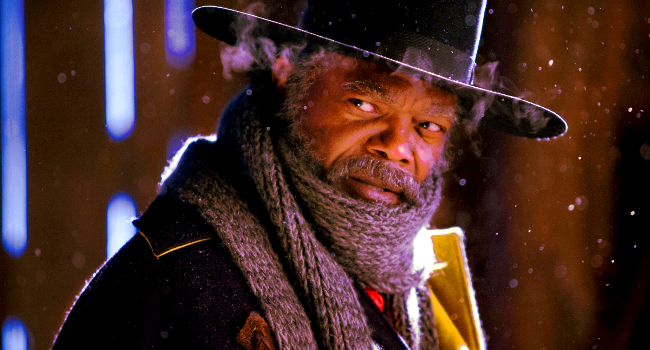I’ve been following the critical response to The Hateful Eight very closely, and I’ve managed to bite my tongue about my thoughts on the film until after the movie played in its roadhouse edition and then opened wide to the general theater audience. I also kept my review from this blog until after it had run through the holidays in a special two-week edition of The Contributor. I saw the movie about a week before it opened in Nashville. Here’s how I saw it…
The saga of the stranded murderers, marauders, bounty hunters and soldiers in Quentin Tarantino’s The Hateful Eight is only slightly more blood-soaked than the saga of the film’s announcement and sudden cancellation in 2014: In November, 2013 Tarantino revealed that he was writing a new Western that would not be a sequel to Django Unchained. In January of 2014 the The Hateful Eight title was announced along with plans to begin filming in the summer, but by the end of that month Tarantino’s outrage over a script leak had him shelving the project and threatening to turn it into a novel. However, by late winter of 2014 rumors that the film was back on track began to spread, and by that spring Tarantino was hosting public script readings with a live cast.
Now that the film has finally arrived one can still imagine a world where The Hateful Eight never got made: It would be a shame for audiences to miss the gorgeous light captured by my favorite contemporary cinematographer, Robert Richardson or the excellent ensemble acting or the laugh-out-loud dialog that fills this most talkative of the director’s talkative films. That said, The Hateful Eight, like Django Unchained, won’t stand with Tarantino’s best, and audiences reminded about the ruckus over the leaked script will scratch their heads wondering why the director was so precious with what amounts to a gory, Western comedy that also plays with the tropes of a parlor mystery.
Like some of the director’s other films, Hateful’ is told in separate chapters that split the film into two distinct sections. In the first half a bounty hunter and his prisoner are in a stagecoach racing a blizzard to shelter – they rescue another bounty hunter and a sheriff along the way. The group arrives at Minnie’s Haberdashery to find the spaced already hosting an English hangman, a cowboy, a Confederate General and a Mexican caretaker left in charge while the proprietors – Minnie and Sweet Dave – are visiting Minnie’s mom. After tempers flare in close confines and the first body falls, it’s revealed that the coffee’s been poisoned. The second half of the film takes on the feel of an Agatha Christie whodunit with more beards and blood and blue language than Christie ever conceived of.
Hateful’s structure mostly recalls Tarantino’s first feature, Reservoir Dogs. That film also used a non-linear script which found a cast of bad guys meeting in a warehouse after a diamond heist gone wrong. Hateful relies on the same one-setting formula, substituting Minnie’s catch-all frontier outpost for the warehouse. The movie also recalls Jackie Brown with its near-constant dialog, and even From Dusk Till Dawn with its halfway-point genre-shifting.
A Tarantino dream cast brings his cantankerous characters to livid life: Kurt Russell’s bounty hunter John “The Hangman” Ruth is full of movie star swagger with just a hint of a John Wayne accent – he’s the closest thing Hateful has to a protagonist. Samuel L. Jackson is predictably outstanding as Major Marquis Warren – a Union soldier who’s also become a bounty hunter in the years just after the Civil War. Bruce Dern brings gray-haired gravitas to his portrayal of Confederate General Sanford Smithers, but Walton Goggins steals the show as Chris Mannix, a Southern renegade and the new Sheriff of Red Rock – the travelers’ elusive destination. The costumes and the detailed sets equal the performances, and the movie is already creeping onto year-end best-of polls and awards nominations lists.
But, The Hateful Eight is ultimately a disappointment. At his best, Tarantino can raise schlocky genre fare to the level of visceral high art: Seeing Tim Roth soaked in blood in Reservoir Dogs was sad and sickening. When Michael Madsen carved-off a cop’s ear in that same film it was genuinely shocking. When the long conversation in the basement bar in Inglourious Basterds finally erupts in a blood bath, the tension is wound-up to a virtuosic crescendo of breathtaking violence. But here, as in Django’, blood mostly sprays for laughs. Tarantino’s given us some of the strongest heroines in contemporary cinema, but he reduces Jennifer Jason Leigh’s Daisy Domergue character to a punching bag. Jackson’s hyperbolic monolog about a vengeful sexual assault is simply ridiculous, and by the time the barrels start to blaze in the movie’s second half I wanted to care more than I did or at least feel a little surprised. But, I didn’t care and I wasn’t surprised, and most audiences won’t be either.








